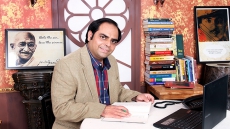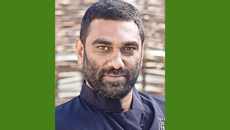"It gives me great happiness to serve as a role model to aspiring scientists, particularly girls. Challenges are placed in our lives to serve as stepping stones.”
One doesn’t become senior staff scientist at the European Organization for Nuclear Research (CERN) Laboratory without having serious drive. Archana Sharma found her vocation early on and never looked back: “I knew I didn’t want to become a doctor as the sight of blood made me giddy. The options were physics, chemistry and mathematics. Of the three, my physics teacher was one of the best and sparked my interest.” Her professor would be proud. Sharma is now an authority on gaseous detectors for research in high energy physics. She’s also a pioneer in simulation and experimentation on wire chambers and resistive plate chambers.
Finding success in her specialty has a lot to do with how Sharma focuses her attention: “I’m conscious about how I use my time; this learning comes from years managing and balancing work and family duties. The impact of my focus and alignment with my goals decide where my attention goes.” A Nuclear Physics graduate from Banaras Hindu University in Varanasi, India, Sharma got her Particle Physics Ph.D. from Delhi University and a D.Sc. from the University of Geneva. Suffice to say, Sharma believes in the transformative power of education: “It gives me great happiness to serve as a role model to aspiring scientists, particularly girls. Challenges are placed in our lives to serve as stepping stones.”
To date, Sharma has authored or co-written over 800 publications. She also credits this achievement to the collaboration and team work of her team in her field. The scientist puts her beliefs into action through the non-profit Life Lab Foundation. The purpose of the organization is to connect students and teachers with the world’s leading scientific organizations. The idea is to give them access to experts and cutting-edge science via training visits, workshops and competitions. Sharma found inspiration in her own early learning experiences: “I want to make a meaningful difference by engaging students in hands-on activities that go beyond the confines of classrooms and encourage them to think uniquely, creatively and critically.”

Education is a never ending endeavour and Sharma has been, alongside the rest of CERN, involved in the demystification of the Large Hadron Collider: “Early on, the biggest public misconception was that the world will come to an end (because of it). In my humble opinion, any publicity is good publicity: it provided us scientists with a vehicle to go out there, explain realities and mitigate safety concerns. After the discovery of the Higgs Boson, the public was more ready to receive information and further their knowledge.”
How do you strive to always do your best?
Although now it’s rather common to see Indians working at CERN, three decades ago it wasn’t so. Been an outlier put pressure on me: I couldn’t let anyone down, my people, my country, my family. I always strive to do my best, improve myself, learn from mistakes and ensure nothing important falls through the cracks, either at work or at home.
Indians around the world have made significant contributions to the countries that received them. How do you explain this drive?
In countries where Indians are doing well, a share of their success can be attributed to the systems and facilitations that exist abroad. That said, the rather traditional family values of the average Indian, acceptance of difficulties, awareness of the link between education and success, and daily multitasking in a multicultural environment give Indians an edge.
How would you say having been born and raised in India has shaped who you are today?
Growing up, the ability to deal with diversity and adversities has made me resilient and tenacious. I don’t give up easily!
(Author’s note: Answers have been edited for brevity.)






